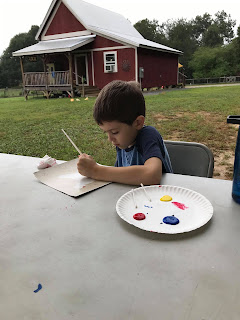 After morning chores and our goat milking was complete, the kids began their art project. Each child had a piece of card stock covered with a contact-paper stencil. We worked on swirling colors to create different looks without blending it all together. We talked a little about the terms homogeneous and heterogeneous, and even applied it to our milk lesson! Milk from the store is "homogenized", or blended together in a way that so the fats cannot separate and float to the top.
After morning chores and our goat milking was complete, the kids began their art project. Each child had a piece of card stock covered with a contact-paper stencil. We worked on swirling colors to create different looks without blending it all together. We talked a little about the terms homogeneous and heterogeneous, and even applied it to our milk lesson! Milk from the store is "homogenized", or blended together in a way that so the fats cannot separate and float to the top.We aren't only working with colors and paints in art... the kids are also learning to listen, follow directions, and improvise when things aren't working the way you want them to! We will be peeling back the chicken stencils next week to reveal their final results!
The class also learned a few Spanish words with Ms. Miranda this week! They learned a few terms for animals here on the farm, and we will post some fun (optional) practice games to do at home.
After lunch, the class worked on handwriting, sang their continents song to review the names of the continents, and learned about animal adaptations. The class focused on different bird beaks and how they are needed for different foods/environments. Ms. Christi led the kids through an activity where they were able to compare different types of beaks in different scenarios. They used a "warbler beak" made from a straw and a "duck bill" made from a paper cup to try to "eat" foods. They found that the warbler beak was able to pick up the foods without picking up other things, like rocks, but the duck bill was better at scooping.
At the end of the day, the students listened to a story about a cactus called, "Cactus Hotel." The story is about the long life of a cactus in the desert. There were many different animal adaptations mentioned in the story, and the students were able to make connections to what they learned in the previous lesson.















No comments:
Post a Comment